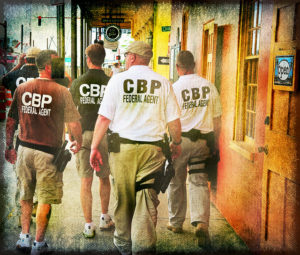The Federal Government Is Helping Police Nationwide Secretly Exploit Intrusive Technologies
Unfortunately, power loves the dark. Cali4beach / CC-BY-2.0
1
2
3
4
Cali4beach / CC-BY-2.0
1
2
3
4
Can’t you see the writing on the touchscreen? A techno-utopia is upon us. We’ve gone from smartphones at the turn of the twenty-first century to smart fridges and smart cars. The revolutionary changes to our everyday life will no doubt keep barreling along. By 2018, so predicts Gartner, an information technology research and advisory company, more than three million employees will work for “robo-bosses” and soon enough we — or at least the wealthiest among us — will be shopping in fully automated supermarkets and sleeping in robotic hotels.
With all this techno-triumphalism permeating our digitally saturated world, it’s hardly surprising that law enforcement would look to technology — “smart policing,” anyone? — to help reestablish public trust after the 2014 death of Michael Brown in Ferguson, Missouri, and the long list of other unarmed black men killed by cops in Anytown, USA. The idea that technology has a decisive role to play in improving policing was, in fact, a central plank of President Obama’s policing reform task force.
In its report, released last May, the Task Force on 21st Century Policing emphasized the crucial role of technology in promoting better law enforcement, highlighting the use of police body cameras in creating greater openness. “Implementing new technologies,” it claimed, “can give police departments an opportunity to fully engage and educate communities in a dialogue about their expectations for transparency, accountability, and privacy.”
Indeed, the report emphasized ways in which the police could engage communities, work collaboratively, and practice transparency in the use of those new technologies. Perhaps it won’t shock you to learn, however, that the on-the-ground reality of twenty-first-century policing looks nothing like what the task force was promoting. Police departments nationwide have been adopting powerful new technologies that are remarkably capable of intruding on people’s privacy, and much of the time these are being deployed in secret, without public notice or discussion, let alone permission.
And while the task force’s report says all the right things, a little digging reveals that the feds not only aren’t putting the brakes on improper police use of technology, but are encouraging it — even subsidizing the misuse of the very technology the task force believes will keep cops honest. To put it bluntly, a techno-utopia isn’t remotely on the horizon, but its flipside may be.
Getting Stung and Not Even Knowing It
Shemar Taylor was charged with robbing a pizza delivery driver at gunpoint. The police got a warrant to search his home and arrested him after learning that the cell phone used to order the pizza was located in his house. How the police tracked down the location of that cell phone is what Taylor’s attorney wanted to know.
The Baltimore police detective called to the stand in Taylor’s trial was evasive. “There’s equipment we would use that I’m not going to discuss,” he said. When Judge Barry Williams ordered him to discuss it, he still refused, insisting that his department had signed a nondisclosure agreement with the FBI.
“You don’t have a nondisclosure agreement with the court,” replied the judge, threatening to hold the detective in contempt if he did not answer. And yet he refused again. In the end, rather than reveal the technology that had located Taylor’s cell phone to the court, prosecutors decided to withdraw the evidence, jeopardizing their case.
And don’t imagine that this courtroom scene was unique or even out of the ordinary these days. In fact, it was just one sign of a striking nationwide attempt to keep an invasive, constitutionally questionable technology from being scrutinized, whether by courts or communities.
The technology at issue is known as a “Stingray,” a brand name for what’s generically called a cell site simulator or IMSI catcher. By mimicking a cell phone tower, this device, developed for overseas battlefields, gets nearby cell phones to connect to it. It operates a bit like the children’s game Marco Polo. “Marco,” the cell-site simulator shouts out and every cell phone on that network in the vicinity replies, “Polo, and here’s my ID!”
Thanks to this call-and-response process, the Stingray knows both what cell phones are in the area and where they are. In other words, it gathers information not only about a specific suspect, but any bystanders in the area as well. While the police may indeed use this technology to pinpoint a suspect’s location, by casting such a wide net there is also the potential for many kinds of constitutional abuses — for instance, sweeping up the identities of every person attending a demonstration or a political meeting. Some Stingrays are capable of collecting not only cell phone ID numbers but also numbers those phones have dialed and even phone conversations. In other words, the Stingray is a technology that potentially opens the door for law enforcement to sweep up information that not so long ago wouldn’t have been available to them.
All of this raises the sorts of constitutional issues that might normally be settled through the courts and public debate… unless, of course, the technology is kept largely secret, which is exactly what’s been happening.
After the use of Stingrays was first reported in 2011, the American Civil Liberties Union (ACLU) and other activist groups attempted to find out more about how the technology was being used, only to quickly run into heavy resistance from police departments nationwide. Served with “open-records requests” under Freedom of Information Act-like state laws, they almost uniformly resisted disclosing information about the devices and their uses. In doing so, they regularly cited nondisclosure agreements they had signed with the Harris Corporation, maker of the Stingray, and with the FBI, prohibiting them from telling anyone (including other government outfits) about how — or even that — they use the devices.
Sometimes such evasiveness reaches near-comical levels. For example, police in the city of Sunrise, Florida, served with an open-records request, refused to confirm or deny that they had any Stingray records at all. Under cover of a controversial national security court ruling, the CIA and the NSA sometimes resort to just this evasive tactic (known as a “Glomar response“). The Sunrise Police Department, however, is not the CIA, and no provision in Florida law would allow it to take such a tack. When the ACLU pointed out that the department had already posted purchase records for Stingrays on its public website, it generously provided duplicate copies of those very documents and then tried to charge the ACLU $20,000 for additional records.
Your support matters…Independent journalism is under threat and overshadowed by heavily funded mainstream media.
You can help level the playing field. Become a member.
Your tax-deductible contribution keeps us digging beneath the headlines to give you thought-provoking, investigative reporting and analysis that unearths what's really happening- without compromise.
Give today to support our courageous, independent journalists.






You need to be a supporter to comment.
There are currently no responses to this article.
Be the first to respond.